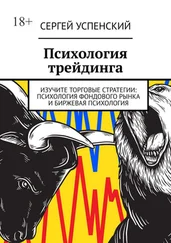Diener, E., Sandvik, E., & Pavot, W. (1991). Happiness is the frequency, not the intensity, of positive versus negative affect. In F. Strack, M. Argyle, and N. Schwartz (Eds.), Subjective well-being: An interdisciplinary perspective (pp. 119–139). Oxford: Pergamon.
Elder, A. (1993). Trading for a living. New York: Wiley.
Elkin, I., Shea, M.Т., Watkins, J.Т., Imber, S.D., Sotsky, S.M., Collins, J.F., Glass, D.R., Pikonis, P.A., Leber, W.R., Docherty, J.P., Fiester, S.J., and Parloff, M.B. (1989). National Institute of Mental Health Treatment of Depression Collaborative Program: General effectiveness of treatments. Archives of General Psychiatry, 46, 971–982.
Ericsson, K.A. (1996). The acquisition of expert performance: An introduction to some of the issues. In K. A. Ericsson (Ed.), The road to excellence: The acquisition of expert performance in the arts and sciences, sports and games (pp. 1–50). Mahwah, NJ: Erlbaum.
Fenton-O’Creevy, M„Soane, E., & Willman, P. (1999, August). Trading on illusions: Unrealistic perceptions of control and trading performance. Academy of Management Conference, Chicago, IL.
Flavell, J.H. (1963). The developmental psychology of Jean Piaget. New York: Van Nostrand.
Galton, F. (1869). Hereditary genius: An inquiry into its laws and consequences. London: Macmillan.
Gazzaniga, M.S. (1998). The mind’s past. Berkeley: University of California Press.
Goldberg, A. (1999). Being of two minds: The vertical split in psychoanalysis and psychotherapy. Hillsdale, NJ: Analytic Press.
Goldberg, E. (2001). The executive brain: Frontal lobes and the civilized mind. New York: Oxford University Press.
Grinder, G., & Bandler, R. (1981). Trance-formations: Neuro-linguistic programming and the structure of hypnosis. Moab, UT: Real People Press.
Gurdjieff, G.I. (1984). Views from the real world: Early talks of G.I. Gurdjieff. London: Arkana.
Haley, J. (1986). Uncommon therapy: The psychiatric techniques of Milton H. Erickson, M. D. New York: Norton.
Hastie, R., & Park, B. (1997). The relationship between memory and judgment depends on whether the judgment task is memory-based or on-line. In W. Goldstein and R.M. Hogarth (Eds.), Research on judgment and decision making: Currents, connections, and controversies (pp. 431–453). Cambridge: Cambridge University Press.
Hirsch, Y., & Hirsch, J.A. (2002). Stock trader’s almanac 2002. Old Tappan, NJ: Hirsch Organization.
Isen, A.M. (1997). Positive affect and decision making. In W.M. Goldstein and R.M. Hogarth (Eds.), Research on judgment and decision making: Currents, connections, and controversies (pp. 509–536). Cambridge: Cambridge University Press.
Kelly, G. (1963). Theory of personality: The psychology of personal constructs. New York: Norton.
Kiev, A. (2001). Trading in the zone. New York: Wiley.
Lazarus, R.S., & Folkman, S. (1984). Stress, appraisal, and coping. New York: Springer.
LeDoux, J. (1996). The emotional brain: The mysterious underpinnings of emotional life. New York: Touchstone.
Lee, С.M., & Swaminathan, B. (2000). Price momentum and trading volume. Journal of Finance, 55, 2017–2069.
Libet, B. (1985). Unconscious cerebral initiative and the role of unconscious will in voluntary action. The Brain and Behavioral Sciences, 8, 529–566.
Lo, A.W., & Repin, D.V. (2001). The psychophysiology of real-time financial risk processing. Working paper: Massachusetts Institute of Technology Sloan School of Management.
Lombardi, V., Jr. (2001). What it takes to be #1: Vince Lombardi on leadership. New York: McGraw-Hill.
Lowen, A. (1995). Joy: The surrender to the body and to life. New York: Arkana.
Mahrer, A.R. (1989). Dreamwork in psychotherapy and self-change. New York: Norton.
Markman, J. (2001). Online investing: How to find the right stocks at the right time. Redmond, WA: Microsoft Press.
Maslow, A. (1998). Toward a psychology of being (3rd ed). New York: Wiley.
Mathieu, W.A. (1991). The listening book: Discovering your own music. Boston: Shambhala.
McCrae, R.R., & Costa, P.T. (1996). Toward a new generation of personality theories: Theoretical contexts for the Five-Factor Model. In J.S. Wiggins (Ed.), The Five-Factor Model of personality: Theoretical perspectives (pp. 51–87). New York: Guilford.
Meichenbaum, D. (1977). Cognitive-behavior modification. New York: Plenum.
Mentzer, M. (1997). Mike Mentzer’s high intensity training program. New York: Advanced Research Press.
Murphy, M. (1992). The future of the body: Explorations into the further evolution of human nature. Los Angeles: Tarcher.
Niederhoffer, V. (1997). The education of a speculator. New York: Wiley.
Norretranders, T. (1998). The user illusion: Cutting consciousness down to size. New York: Penguin.
Odean, T. (1999). Do investors trade too much? American Economic Review, 89, 1279–1298.
Ornstein, R. (1997). The right mind. San Diego: Harcourt Brace.
Ouspensky, P.D. (1971). The fourth way. New York: Vintage.
Pennebaker, J.W. (1993). Social mechanisms of constraint. In D.M. Wegner and J.W. Pennebaker (Eds.), Handbook of mental control (pp. 200–219). Englewood Cliffs, NJ: Prentice-Hall.
Pirsig, R.M. (1974). Zen and the art of motorcycle maintenance. New York: Morrow.
Pious, S. (1993). The psychology of judgment and decision making. New York: McGraw-Hill.
Polanyi, M. (1967). The tacit dimension. Garden City, NY: Anchor.
Ramachandran, V.S., & Blakeslee, S. (1998). Phantoms in the brain: Probing the mysteries of the human mind. New York: Morrow.
Raschke, L. (2001). Trading my way: Professional trading techniques. Wellington, FL: LBRGroup.
Reber, A.S. (1993). Implicit learning and tacit knowledge: An essay on the cognitive unconscious. New York: Oxford University Press.
Sacks, O. (1996). An anthropologist on Mars. New York: Vintage Books.
Schiffer, F. (1998). Of two minds: The revolutionary science of dual-brain psychology. New York: Free Press.
Schwager, J.D. (1989). Market wizards: Interviews with top traders. New York: Harper & Row.
Schwager, J.D. (1992). The new market wizards: Conversations with America’s top traders. New York: HarperBusiness.
Shapiro, F., & Forrest, M. S. (1997). EMDR: Eye movement desensitization and reprocessing. New York: Basic.
Shefrin, H. (2000). Beyond fear and greed: Understanding behavioral finance and the psychology of investing. Boston: Harvard Business School Press.
Sherry, C.J. (1992). The mathematics of technical analysis: Applying statistics to trading stocks, options and futures. Chicago: Probus.
Simonton, D.K. (1994). Greatness: Who makes history and why. New York: Guilford.
Sperry, R.W. (1969). A modified concept of consciousness. Psychological Review, 76, 532–536.
Steenbarger, B.N. (1992). Toward science-practice integration in brief counseling and therapy. Counseling Psychologist, 20, 403–450.
Steenbarger, B.N. (1994). Duration and outcome in psychotherapy: An integrative review. Professional Psychology: Research and Practice, 25, 111–119.
Steenbarger, B.N. (2002). Brief therapy. In M. Hersen and W.H. Sledge (Eds.), The encyclopedia of psychotherapy. San Diego, CA: Academic.
Steenbarger, B.N. (2002). Single session therapy. In M. Hersen and W.H. Sledge (Eds.), The encyclopedia of psychotherapy (pp. 669–672). San Diego, CA: Academic.
Читать дальше
Конец ознакомительного отрывка
Купить книгу




![Вадим Георгиенко - Навстречу людям. Шаг за шагом[практические механизмы участия общественности в процессах принятия решений на местном уровне]](/books/192080/vadim-georgienko-navstrechu-lyudyam-shag-za-shagom-pra-thumb.webp)






